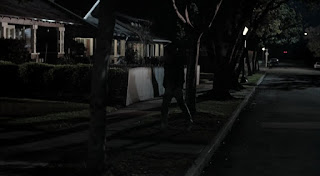It doesn’t appear Wes Craven had a whole lot going on during the mid-to-late 1980s, his only real film contributions being Deadly Friend and The Serpent and the Rainbow. Other than that, a made-for-TV movie called Chiller, something for The Wonderful World of Disney, and a handful of episodes of the new Twilight Zone. I can’t imagine his career had taken the trajectory he’d wanted, or even anticipated, especially after the astronomical success of the original A Nightmare on Elm Street.
Wes, I’m sure, wasn’t a
happy camper when his script for A Nightmare on Elm Street 3: The Dream
Warriors was ultimately rejected (only elements of his original story were
used in the final script penned by Bruce Wagner and Frank Darabont, with
contributions by director Chuck Russell), or when he was fired (*ahem* pardon
me, replaced) from the 1987 adaptation of the classic V.C. Andrews novel
Flowers in the Attic (Jeffrey Bloom slipped into the director’s chair
soon after Craven’s departure).
He couldn’t have been too
upset, however, as he was collecting checks for Elm Street-related
endeavors with which he had nothing to do, a la additional sequels, the Freddy’s
Nightmares television series, a Nintendo game, and a shitload of
merchandising/endorsement deals. “Krueger Kash,” I giddily imagine he’d
referred to it as, his naked body rolling about a large bed peppered with green
bills, Indecent Proposal-style. He must’ve realized that A Nightmare
on Elm Street was truly where his bread was buttered, Freddy’s clawed hand
the one that fed him, and if he were to garner any future success (that is, real
success) in the horror genre, he’d have to find some way to get back in on
the action—or at least come up with something comparable.
And in 1989, Shocker,
as well as its Krueger-inspired villain, were born.
There’s no denying the
similarities between Shocker and the Elm Street series, namely
the dream element and a mass murderer who returns subsequent to his ultimate
demise (here, we have justice by the legal system, while in the A Nightmare
on Elm Street backstory, the killer’s execution is orchestrated by a group
of parents-turned-vigilantes). Along with Horace Pinker’s Krueger-style quips
and wisecracks, we have a number of Elm Street nuances, some of them
seen in the sequels Craven had nothing to do with (body jumping, the “trapping
a supernatural villain in order to return him to the real world” concept,
etc.). There main character’s adoptive father is a member of the police force,
a nod to the original Elm Street, a cameo by Heather Langenkamp, and a
scene involving a little girl on a tricycle, for fuck’s sake.
Shocker is far from a perfect film. In addition to its many
similarities to an incredibly lucrative franchise, there are some definite
pacing issues. A movie of this kind, which should be judged solely on its
entertainment value, shouldn’t have a running time beyond 90 minutes (Shocker
is 10 minutes shy of 2 hours). Because of the film’s length, I was forced
to go snap-happy yet again, this time going much further than I have thus far.
Here, I present more than 1,100 high quality images taken from the Blu ray
edition. Enjoy.
On a small sidenote, some
years before his death, Wes Craven mentioned plans to remake both Shocker and
The People Under the Stairs, as he felt both could be much better,
especially with today’s technology. Flawed though it may be, I think Shocker
is fine the way it is. As for The People Under the Stairs, well,
that’s a different story.




































































































































































































































































































































































































































































































































































































































































































































































































































































































































































































































































































































































































